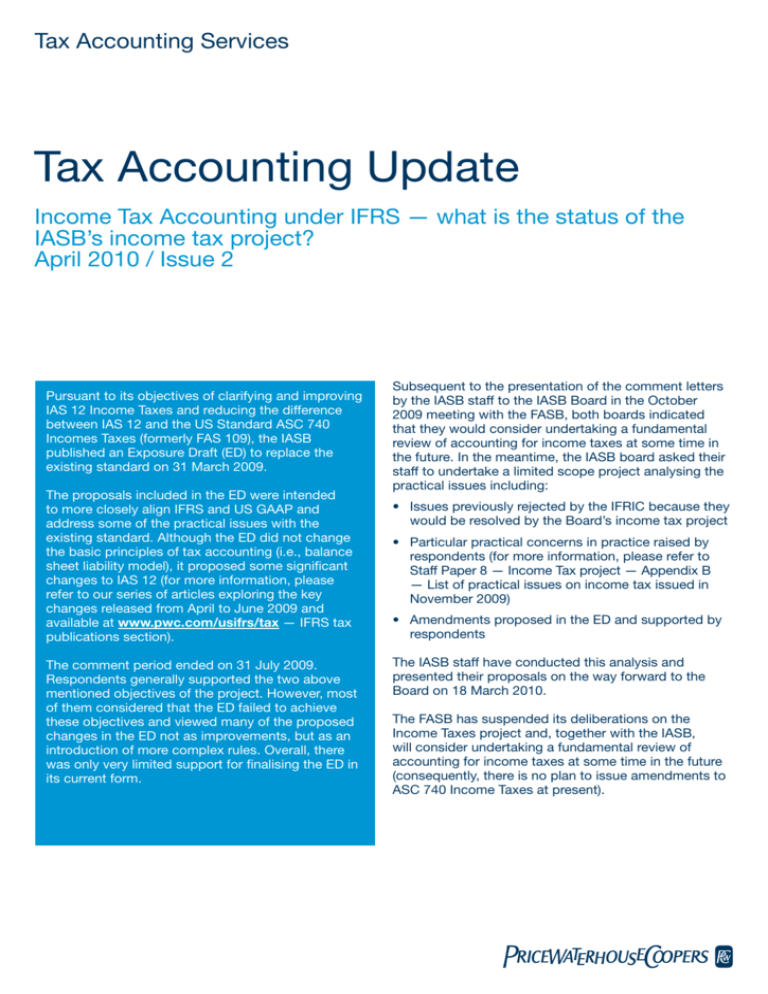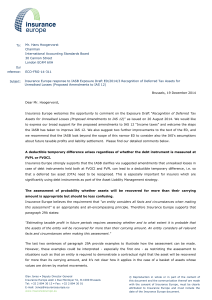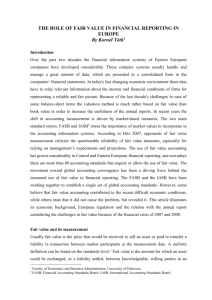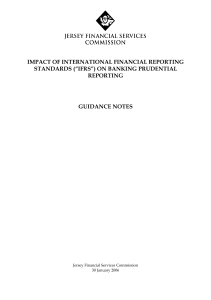
Tax Accounting Services
Tax Accounting Update
Income Tax Accounting under IFRS — what is the status of the
IASB’s income tax project?
April 2010 / Issue 2
Pursuant to its objectives of clarifying and improving
IAS 12 Income Taxes and reducing the difference
between IAS 12 and the US Standard ASC 740
Incomes Taxes (formerly FAS 109), the IASB
published an Exposure Draft (ED) to replace the
existing standard on 31 March 2009.
The proposals included in the ED were intended
to more closely align IFRS and US GAAP and
address some of the practical issues with the
existing standard. Although the ED did not change
the basic principles of tax accounting (i.e., balance
sheet liability model), it proposed some significant
changes to IAS 12 (for more information, please
refer to our series of articles exploring the key
changes released from April to June 2009 and
available at www.pwc.com/usifrs/tax — IFRS tax
publications section).
The comment period ended on 31 July 2009.
Respondents generally supported the two above
mentioned objectives of the project. However, most
of them considered that the ED failed to achieve
these objectives and viewed many of the proposed
changes in the ED not as improvements, but as an
introduction of more complex rules. Overall, there
was only very limited support for finalising the ED in
its current form.
Subsequent to the presentation of the comment letters
by the IASB staff to the IASB Board in the October
2009 meeting with the FASB, both boards indicated
that they would consider undertaking a fundamental
review of accounting for income taxes at some time in
the future. In the meantime, the IASB board asked their
staff to undertake a limited scope project analysing the
practical issues including:
• Issues previously rejected by the IFRIC because they
would be resolved by the Board’s income tax project
• Particular practical concerns in practice raised by
respondents (for more information, please refer to
Staff Paper 8 — Income Tax project — Appendix B
— List of practical issues on income tax issued in
November 2009)
• Amendments proposed in the ED and supported by
respondents
The IASB staff have conducted this analysis and
presented their proposals on the way forward to the
Board on 18 March 2010.
The FASB has suspended its deliberations on the
Income Taxes project and, together with the IASB,
will consider undertaking a fundamental review of
accounting for income taxes at some time in the future
(consequently, there is no plan to issue amendments to
ASC 740 Income Taxes at present).
Recent developments
Treatment of uncertain tax positions
One of the areas of focus highlighted by the IASB
staff paper presented to the Board in the October
joint meeting with the FASB relates to uncertain tax
positions. This was one of the convergence issues that
respondents to the ED on Income Taxes suggested that
the Board reconsider. The IASB staff have commented
that having no specific requirements on uncertain tax
positions is a substantial gap in IAS 12 that should
be filled. However, they have recommended that this
issue not be addressed until the amendments to IAS
37 Provisions, Contingent Liabilities and Contingent
Assets are finalised. This will allow the recognition and
measurement requirements for uncertain tax positions
in the scope of IAS 12 to be consistent with the general
requirements for uncertain liabilities included in IAS 37.
The IASB published a limited Exposure Draft of proposed
amendments to IAS 37 on 5 January 2010 (please
refer to our IFRS bulletin released in January 2010,
summarising the proposals and available at www.pwc.
com/ifrs — publications section — Straight Away). The
IASB originally published an Exposure Draft to replace
IAS 37 in June 2005. In the light of comments received
on this ED and subsequent discussions, the Board has
revised the proposals in the ED primarily to provide
more guidance on applying the proposed measurement
requirements. The comment period for the new January
2010 ED will end on 19 May 2010, with the new standard
expected to be published in the third quarter of 2010.
The new proposals require that the measurement of
provisions should be the amount that an entity would
rationally pay at the measurement date to be relieved of
the liability. This amount is expressed in the ED as the
lowest of:
• The present value of the resources required to fulfil
the obligation;
• The amount the entity would have to pay the
counterparty to cancel the obligation; and
• The amount the entity would have to pay a third
party to transfer the obligation to that third party.
Appendix B to the ED provides comprehensive
guidance on the expected present value technique: the
estimate would take into account the expected outflows
of resources, the time value of money and the risk that
the actual outflows might ultimately differ from the
expected outflows.
Tax Accounting Update
PricewaterhouseCoopers
If the liability is to pay cash to a counterparty, the
outflows would be the expected cash payments plus any
associated costs. If the liability is to undertake a service
at a future date, the outflows would be the amounts
that an entity estimates it would pay a contractor at the
future date to undertake the service on its behalf.
Related tax accounting questions to consider
From a tax accounting perspective, some questions come
to mind in contemplating the practical application of the
IASB’s proposed measurement of uncertain liabilities:
1) Does the proposed measurement guidance of
uncertain liabilities apply to uncertain tax positions?
The snapshot of IAS 37 revised by the IASB in January
2010 specifies that IAS 37 does not apply to items such
as, among others, income tax liabilities because they
are within the scope of other standards.
It is possible that the proposed amendments to IAS 12
will be consistent with the final IAS 37 model. The final
IAS 37 is likely to apply to uncertain tax positions related
to non-income based taxes (i.e., related to taxes excluded
from the scope of IAS 12 such as VAT and sales taxes).
2) If the proposed guidance of uncertain liabilities
applies to uncertain tax positions, how would it apply?
The proposed amendments to IAS 37 require that the
provision for uncertain liabilities would take into account
the expected outflows of resources, the time value
of money and the risk that the actual outflows might
ultimately differ from the expected ones. A tax liability
is an obligation to pay cash to a counterparty, so the
outflows would be the expected cash payments plus
any associated costs.
How would the IAS 37 model apply to uncertain tax
positions? Would they be considered to be the best
estimate of the amount to pay after negotiation with the
Tax Authorities or would they be assessed based on the
present value technique specified in the ED of IAS 37
replacement (i.e., a probability-weighted average of the
present value of the expected cash payments for all the
possible outcomes)?
At present this is not clear and does not clarify
concerns of respondents to the ED of IFRS replacing
IAS 12 on the uncertain tax positions issue.
April 2010 / Issue 2
2
Next steps
The comment period for responses to the ED of proposed
amendments to IAS 37 ends on 19 May 2010. We
encourage companies to consider the implications of the
proposal and provide the IASB with comments.
Deferred taxes on investment property revaluation
gains
When a company measures an investment property
at fair value under the fair value model in IAS 40,
this creates a temporary difference, unless the
remeasurement at fair value also results in an equal
adjustment to the tax base of the asset at the same time
(a similar temporary difference arises from revaluation
of an asset under other IFRSs). Under IAS 12, the
company must determine how it expects to recover the
carrying amount of the property, as that expectation
determines the tax base of the asset and the applicable
tax rate to apply to any temporary difference that exists.
For example, if a company has measured a property
at fair value and expects to recover its carrying
amount through future rental receipts, it would have to
determine the tax base and the applicable tax rate that
apply to the rental receipts and provide deferred tax on
the resulting temporary difference using that income
tax rate regardless of whether there would be any tax
payable on a sale of the property.
However, many companies in jurisdictions where there
is no capital gains tax on sale of properties argue
that no deferred tax liabilities should be recognised in
such situations, regardless of the expectation of the
manner of recovery. Similarly, where gains on sale of the
property are tax free but there is a tax on the claw back
of previously claimed tax depreciation for the property,
many companies argue that a deferred tax liability
should be recognised only for the claw-back portion.
To address this issue, the ISAB staff proposed a new
exception under IAS 12. Broadly, the new exception
would exempt entities from recognising deferred tax
for temporary differences arising from remeasurement
of assets and liabilities at a fair value to the extent that
a market participant acquiring the asset or assuming
the liability for the fair value would have the same
temporary differences.
Tax Accounting Update
PricewaterhouseCoopers
However, the Board rejected the staff’s proposed
solution to the accounting for deferred tax on
investment properties and suggested a simpler,
broader exemption for investment property measured
at fair value under IAS 40, based on the lower of tax
consequences of sale or use.
Other matters
At their meeting on 18 March 2010 the Board endorsed
the IASB staff’s proposal that the scope of the limited
scope project to amend IAS12 Income Taxes should
focus on resolving the problems in practice under the
standard, without changing the fundamental approach
under IAS, and preferably without increasing divergence
from US GAAP (i.e. ASC 740).
In addition to tackling uncertain tax positions and
deferred tax an investment property revaluations, the
Board agreed that the scope of the project should
include the introduction of the proposals in the ED
Income Tax on:
(i) the introduction of an initial step to consider
whether the recovery of an asset or settlement of
liability will affect taxable profit;
(ii) the recognition of a deferred tax asset in full and
an offsetting valuation allowance to the extent
necessary;
(iii) guidance on assessing the need for a valuation
allowance;
(iv) guidance on the meaning of substantive enactment;
and
(v) the allocation of current and deferred taxes within a
group that a consolidated tax return.
In addition, the Board indicated that it would explore
the possibility of resolving the issue of the tax effect of
dividends by entities, such as real estate investment
trusts and co-operative societies.
The staff will outline proposals on the above issues to
Board meetings starting in the third quarter of 2010.
We will monitor progress on these issues and update
readers of further developments in due course.
Please note the above is for information purposes only
and should not be relied on as final advice.
April 2010 / Issue 2
3
Contacts
PricewaterhouseCoopers’ Tax Accounting Services group is a global network of tax professionals providing tax
accounting services, technical knowledge and support. If you would like to discuss any issues with respect to tax
accounting please contact your Tax engagement partner, Assurance engagement team, or one of the specialists
below.
Hong Kong
Shanghai
Singapore
Guy Ellis — Tax Partner
+852 2289 3600
guy.ellis@hk.pwc.com
Terry Tam — Tax Partner
+86 21 2323 1555
terry.sy.tam@cn.pwc.com
Paul Cornelius — Tax Partner
+65 6236 3718
paul.cornelius@sg.pwc.com
Suzanne Wat — Tax Partner
+852 2289 3002
suzanne.wat@hk.pwc.com
pwchk.com
This publication has been prepared by PricewaterhouseCoopers for general guidance on matters of interest only, and is not intended to provide specific advice on any matter, nor is it intended to be
comprehensive. No representation or warranty (express or implied) is given as to the accuracy or completeness of the information contained in this publication, and, to the extent permitted by law,
PricewaterhouseCoopers firms do not accept or assume any liability, responsibility or duty of care for any consequences of you or anyone else acting, or refraining to act, in reliance on the information
contained in this publication or for any decision based on it. If specific advice is required, or if you wish to receive further information on any matters referred to in this publication, please speak with your
usual contact at PricewaterhouseCoopers or those listed in this publication.
© 2010 PricewaterhouseCoopers. All rights reserved. “PricewaterhouseCoopers” refers to the Hong Kong firm of PricewaterhouseCoopers or, as the context requires, the network of member firms of
PricewaterhouseCoopers International Limited, each of which is a separate and independent legal entity.







